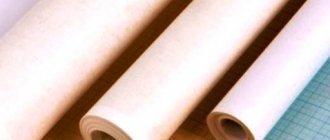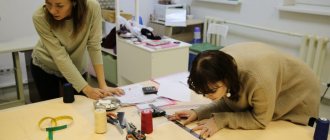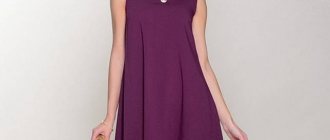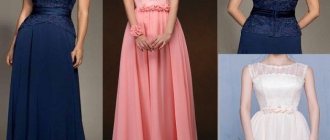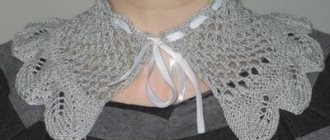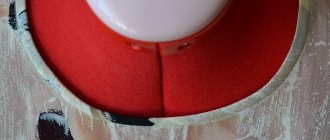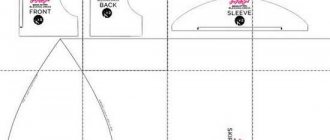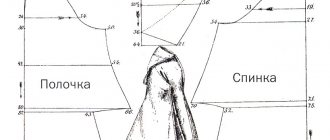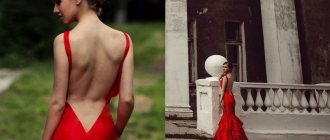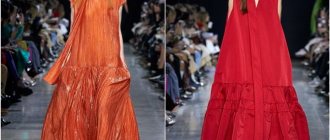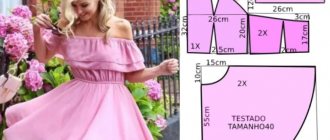Tools for sewing knitwear
There is no need for special equipment for working with knitwear. It is important to have on hand:
Sewing machine. It should be supplied with:
- Needles with a rounded head. There are several varieties: “jersey” or “stretch”. The first variety is sewing knitwear with a mixture of wool and cotton. The second is a synthetic fiber with a large percentage of lycra.
Elegant knitted dress
Regarding the size of the required needle, no one can give a comprehensive answer. One thing is clear: the thinner the fabric, the smaller the needle should be for sewing a fabric product.
Note! Before you start sewing, it would be a good idea to sew a stitch on the rags and check the quality of the sewing.
- Double needle - removable mechanism. Feature: makes several stitches at the same time. Suitable for piping the bottom of the product, armholes. The front side will have parallel stitches and the back side will have zigzag stitches.
Double needle - removable mechanism
Important! The double needle is suitable for any type of sewing machine.
Threading a double needle is done from two spools at the same time. Reels are installed on both pins of the machine so that they can be unwinded in different directions. This will eliminate the possibility of thread tangling. If the machine has one pin, then the second spool is placed in a box and the thread is wound.
Making a knitted dress
A knitted dress requires fewer technological operations than a similar fabric product. The elastic fabric, hugging the figure, allows you to ignore darts to create volumes and change planes.
vovk.com
After making the structure, it is necessary to cut out the parts from the prepared fabric, setting aside reserves for processing the seams. The most convenient way to assemble a knitted dress is to sew it on a machine with an overcast stitch. A margin of 0.5-0.7 cm is sufficient for stitching sections with an overlocker; for hemming the bottoms and finishing the neckline, a margin of 1.5-2.0 cm is necessary.
Secrets
If the lower thread does not catch, follow these steps:
- Loosen the needle fastening screw;
- Lower the needles a little lower, but don’t do it too much;
- Clamp the fastening screw;
- Check to see if the defect has been fixed.
Upper conveyor - several layers of stretch fabric are sewn together. This mechanism allows the top layer of fabric to scroll, while the bottom conveyor feeds the bottom panel. The main task of conveyors is to ensure the synchronous movement of two sheets of material.
Sewing on a machine
The mechanism will not be needed if you have a professionally developed habit of manually basting 2 panels of fabric together. This mechanism is necessary for industrial sewing of products; its use significantly saves workers’ time.
The walking foot pushes through the top layer of fabric. For beginner seamstresses, it is better to baste 2 pieces of fabric by hand to begin with.
Note! Threads are selected smooth, elastic with long fiber: polyester, nylon. Most beginning seamstresses do not go into such details as the composition of the thread - they choose from those that are available. The main rule is to match the color scheme of the product.
Material selection
When choosing material for a dress, you need to adhere to the following criteria:
- Decide on a style. With a complex cut of clothing, the material should be thin. If there is drapery, preference should be given to the appropriate type of knitwear;
- Take into account your complexion when choosing material for a dress;
- Surface of matter: glossy or matte. The gloss is suitable for women with ideal figure proportions. A plump woman needs to carefully consider the choice of fabric and style.
- Seasonality of the product. Summer knitwear and winter knitwear will differ in their properties and thickness parameters.
Note! The choice of a specific type of knitted fabric depends on the style of the dress, body shape and wishes.
You may be interested in this: Construction of patterns and instructions for sewing a wedding dress
If knitwear mixed with synthetics stretches, it is not necessary to carry out preparatory work. The pattern of the knitted dress is laid out and the product is cut out.
Cotton knitwear (“linen”) shrinks after several washes. This must be taken into account when cutting the material. You need to wash the material several times and dry it. The material will shrink and after that you can iron the product and cut it. From this fabric you can make a children's suit for a girl, a home set, or a long sundress. This product can be sewn by a novice seamstress.
Ready product
Ironing rule:
- The fabric is ironed from the wrong side, using an iron. Knitwear shines when ironed and does not emit odor. You need to be careful not to smooth out the wrinkle - the tuck will be difficult to remove, it remains for a long time. You can level the material with your palm;
- Avoid stretching the fiber - waves and bubbles will appear on the fabric, which does not look very good on the finished product and interferes with sewing;
- There is no need to move the iron over the fabric. Knitwear is ironed carefully; you just need to press the iron onto the fabric, hold it, release it, and press it again in another place. This movement will be more gentle on the knitted fabric.
- Iron knitwear only when dry. The material may warp, the fabric will stretch to size. This happens when a dry jersey T-shirt is ironed.
Main characteristics of knitwear
Knitted fabric is not similar in its properties to any other fabric. The main distinctive features of this canvas include:
- Hygroscopicity.
- Elasticity.
- Good fit.
- Comfortable to wear.
But despite such positive aspects of the material, it still has certain disadvantages. Often, knitted fabric is prone to stretching.
This is especially pronounced in those fabrics that are loose and coarsely knit with a coarse weave of threads.
Material consumption
The calculation of the material depends on the complexity of the style of the knitted dress pattern, the parameters of the width of the material, and the pattern.
| Style | Quantity of material R.40-46 | Quantity of material R. 50-56 |
| Straight with sleeve | Product length, sleeves + 40 cm | 2 product lengths + 40 cm |
| With sleeves and flared skirt | 2 product lengths, sleeves + 40 cm | Similar to r.40-46 |
| Sundress straight | Product length+ 40 cm | Similar to r.40-46 |
| Flared sundress | 2 product lengths + 40 cm | Similar to R. 40-46 |
Dress pattern
Features and techniques of sewing knitwear
When working with the sequence of making knitwear patterns, the features of the fabrics used for cutting and sewing are taken into account:
- Cut fabrics. Cut like fabric;
- Semi-regular canvases - processing is not carried out on all sides;
- Regular - the parts are knitted in the round, you just need to sew them together.
Cut fabrics
Sewing technique:
- The direction of the grain thread is parallel to the straight edge of the product;
- When cutting, the lower cuts of the lobes are directed in one direction;
- To prevent skew, the material is not stretched across;
- If it is difficult to mark the lines when cutting, you can carefully connect the fabric parts with needles, observing the same seam allowances;
- You should monitor the stretchability and strength of the seam. The seam should not pull or “collect” the material. The product should stretch along with the seam;
- For parts, a shallow cut of the fabric in the allowance area is allowed;
- The edging of the armholes and neckline is done with an oblique strip of fabric;
- The cover stitch is used when processing the neckline;
- If you don't want the seam to stretch, you need to add bias tape when stitching it;
- The turtleneck collar is sewn on, stretching the fabric slightly;
- The bottom is folded by hand using a loose seam. The upper edge of the folded fabric turns inward at a distance of half a centimeter;
- The seams are ironed through gauze during work.
You can't ruin a dress with oil. Amazing outfits made from butter knitwear
You can't spread this butter on bread, but you can use it to make a delightful evening outfit. And you certainly can’t avoid the oily male gaze in it!
This unusual name for knitwear “butter” was not given by chance. The material flows in a gentle cascade over the body, indeed, like warm tropical oil, it is elastic and unusually “tasty” visually. Largely due to its “oily” feature, the fabric will ideally highlight the seductive advantages of the figure and delicately hide imperfections. At the same time, it won’t even hint at a single extra calorie (unless, of course, you want it yourself)! The material will always help you out in situations where you need to make an impression. In it you can “try on” both the role of a fatal beauty and the image of a fairy-tale nymph.
It is believed that oil knitwear was invented in the United Arab Emirates. It is possible that this is so. After all, Easterners know a lot about luxurious fabrics. In addition, the lightweight material is ideal for hot climates. Butter knitwear looks extremely elegant. Outfits made from it seem to languidly whisper about wealth and prosperity.
In the West, this fabric is better known as slinky, that is, tight-fitting. Now butter knitwear is at the peak of popularity and is produced in many countries. Polyester-based textile oil is “beaten” from various ingredients. The composition may include viscose, lycra or spandex. The proportions are different. But! Despite the combination of synthetic fibers, the material is highly breathable and fits perfectly on the skin.
Let's start the tasting. The menu includes “cold” butter and “warm” butter. Which one to choose? I’ll say right away that cold food tastes better on a hot afternoon. This type of knitwear is thin and delicate, with a slight sheen. It is also called “chill”. In moments of summer languor, clothing made from cold oil will allow your skin to enjoy the desired coolness. This magical effect will especially come in handy on the streets of a hot metropolis. The fabric is ideal for summer outfits: dresses, sundresses, skirts and tunics.
But “warm” oil will lubricate your body in cool weather. The knitwear is thicker with a matte finish. It also has one magical feature: when in contact with the skin, this fabric seems to warm the body with its warm, gentle breath. A good option for casual and business wear. Warm oil is ideal for sewing unique and incredibly fashionable transformable dresses today.
A sensation in wedding fashion! Spectacular oil knitwear has recently become simply indispensable at wedding ceremonies. Simply magical and so elegant dresses for bridesmaids are made from it. None of the girls will be offended. Sensual, exciting, flowing - and always flattering, a butterfly dress will suit young ladies of any proportions. The main thing here is to choose a suitable style from a huge variety, and the natural plasticity of the fabric will work its small miracle: it will add elegance and slenderness to the silhouette and delicately disguise everything “extra.”
Oil knitwear is also an impressive colorful extravaganza of color. The range is wide: from appetizing, juicy and even flashy shades to aristocratically restrained tones. Bright fabric, rest assured, will add fuel to the fire of passion and create the unique energy of the celebration. The material drapes beautifully; designers actively use this property in the design of the photo zone, podium, “skirts” for tables and chairs, and columns in the hall.
In general, neither an important celebration nor a dress can be spoiled with oil, rather the opposite. This knitwear, in addition to its seductive appearance, is distinguished by its incredible practicality in wearing. Rest assured, he will not let you down. In “strategic places” (in the area of the elbows, buttocks and knees) you will not see ugly elongated “bags” - the material does not deform or roll down. In addition, clothes made from butter knitwear practically do not wrinkle and dry quickly. So in an outfit made from this unique knitwear you will be like cheese in butter. Easy to care for, low cost, convenient and comfortable to wear - what else is needed for happiness?
Do you know why butter knitwear will not go out of fashion for a long time? There is only one reason: all women are delighted with clothes that highlight their advantages and turn a chic body into a divine one.
But! In fairness, I note that against the background of all these numerous advantages, “butter” knitwear has one sin - its synthetic base. People who are allergic to artificial materials may experience skin irritation.
Pattern for a dress with a stand-up collar
There are several types of stand-up collars:
- Shirt (turn-down with cutting stand). Used for sewing women's blouses and men's shirts. Comfortable to wear, gently fits the neck.
Important. The width and parameters of the stand depend on the configuration of the collar, determined by the model and the designer.
You may be interested in this Step-by-step guide to sewing a cover with an elastic band for a stool
- Turn-down with a one-piece stand;
- Tuxedo Collar;
Pattern for a dress with a stand-up collar
- Mandarin collar. The collar fits snugly to the neck without fastening. In some products, a fastener is provided and is a loop of fabric that is placed over a button with a stem.
To create a pattern, use the pattern of the shelf and the back of the product.
The length of the neckline of the front and back from the pattern is measured (the distance between the control points for sewing in the collar).
A rectangle ABCD is constructed with a length of half the length of the neckline on the pattern, a height of 6.5 cm. 4 cm are laid upward from the point (the width of the collar varies depending on the chosen model). From point D, 3 cm is laid upward. A curved line is drawn for sewing in the collar. The short side of the collar is drawn at a right angle to the piece, the upper side along the pattern or manually.
Cut out several parts along the fold line at the center of the back. Seam allowances are 1.5 cm. The outer part of the collar is duplicated with interlining fabric.
Choose your favorite style of straight dress. Download the pattern and check the correctness of its construction with a measuring tape.
Note! The pattern does not include allowances; fabric is purchased taking into account 4 cm allowances on the sides for hems.
Knitted materials for dresses
Any knitwear looks like knitted fabric. What are these dresses made from:
- Kulir (smooth stitch) is usually made from 100% cotton. Light summer dresses are made from it. Sometimes lycra is added to the cooler to increase elasticity. This material is durable, thin and does not wrinkle.
- Interlock is a smooth, dense fabric similar in structure to elastic. It is made from cotton, sometimes with the addition of elastane. On each side the surface is silky and smooth. Stretch well and return to shape.
- Velor is a fleecy fabric similar to velvet. Wear- and shape-resistant, retains heat. Will keep you warm in the cold season. Festive dresses are made from velor.
- Viscose is an unnatural, but pleasant, breathable and hypoallergenic material. It is combined with elastane or polyester, this makes the product more elastic.
- Jersey is made from any natural or some chemical fibers. Depending on this, the dress can be thin for summer or warm for winter.
- Sweater knitwear is used to make loose-fitting models. It can be light or dense, smooth or with a pile. Textured raised knitting is often present.
There are dresses made from completely synthetic materials - polyester and elastane, or combinations thereof. They do not allow air to pass through, are highly electrified and can cause allergies. They dry quickly, are easy to machine wash and do not wrinkle or fade.
Natural knitted fabrics allow air to reach the body, are pleasant to the touch and comfortable to wear. Cotton products are the most common; they are soft and durable, and inexpensive. They are easier to care for than silk, linen or wool.
Combined fabrics combine all the positive properties of natural and chemical fibers. A significant drawback is the formation of pellets on the product.
Dress pattern with drapery at the waist
The product is based on the pattern of a fitted dress, which is slightly modified using ray lines.
Dress pattern with drapery at the waist
- Cut out the pattern, rays, without cutting 0.5 cm to the edge. Extend the workpiece.
- The darts on the yoke are closed, it is connected to the right side, and the front of the dress is connected to the left.
- The pattern is transferred to the fabric.
- The back of the product is cut along the fold.
- The seam is sewn, which was marked on the pattern in red.
- The stitched part is folded in half, the stitching begins from the fold line of the fabric at a distance of 4 cm to form a hole into which the part of the upper part is threaded.
- It turns out to be assembled in a corner. Afterwards, knots are tied and at the very beginning of the overlock stitch, a fastening is made.
- The upper part is threaded into the hole that was left.
- Fastenings are being made.
- The other 2 seams are sewn together in the same way.
- The middle part of the back is sewn.
- The product is sewn from the sides and along the shoulder seams. Processing the bottom of the dress with a hidden seam, manually.
- The neckline and armholes are processed similarly.
Note! A dress with draping on the belly is perfect for those who have ideal body measurements. Drapery on the bodice will emphasize the dignity of the chest and hide wide hips.
Pattern of a sports dress made of jersey with a hood.
You will need to cut out the details:
- Shelf - a part with a bend;
- Back - 2 pcs.;
- Sleeve - 2 (if there is a seam - 4);
- Hood - 2;
- Hood facing -2;
- Sleeve cuff - 2;
- Bottom cuff - 1.
When working with a pattern, you should always follow the instructions.
Pattern of a sports dress made of jersey with a hood
Step-by-step algorithm
- Taking measurements: chest, arm, waist, hips. Arm length and product length.
Important! Before cutting, the fabric must be steamed. The material may shrink - this must be taken into account. When laying out patterns, the direction of the grain thread is taken into account.
- Selecting a pattern. Select any product you like, download and print the pattern.
- Open it up. The parts are laid out on a canvas folded in 2 layers. Paired - in the singular, parts with a fold - along the fold line. If the canvas has 1 layer, you need to remember about cutting paired parts.
- Savvy. Knitwear is basted by hand. The seams are on the fabric, do not steam them - it is better to make a running seam on the hands. After stitching the product, the basting must be removed. If the product is not basted, then the parts are chipped in the transverse direction of the seam and stitched on a machine.
- Stitching.
Important. You should monitor the tension of the thread - the thread should not be tight.
- The middle seam of the back is sewn. The allowances are ironed on both sides. The back is detached.
- The pocket is overstitched and a zigzag is made. The pocket is sewn to the shelf. All pocket allowances are pre-stitched and ironed from the inside out;
- The middle seam of the sleeve is sewn down (if the sleeve has 2 seams). The seam allowances are ironed. Sleeve stitching. The allowances are ironed, the raglan is steamed. The bottom of the sleeve is processed with a zigzag.
- The cuff is overstitched, ironed, and pinned to the edge of the sleeve. Attach the cuff to the edge. The cuff is folded over, the free edge is swept away, and attached to the previous seam.
- If you decide not to make cuffs and sleeves, fold up the sleeve sections and sew them with a double stitch.
- Shoulder seams are sewn. Iron back, steam.
- Stitching side seams. Sleeve stitching. The armhole and sleeve cap are first cut off with needles and swept away.
- Sew the hood darts. Iron to the center. Finishing the hood neckline with facing. Pin the sections of the hood to the neck. The hood is sewn in. Steamed.
- Grommets are installed.
- The hem of the bottom is stitched with a double needle.
You may be interested in: Rules for sewing buttons with two and four holes
Preparing for sewing
- To make it yourself, you will need the basic design of a shoulder product. Due to the stretchability of knitwear and the possibility of large errors in width, the base can be any size that matches the chest circumference.
- To find the degree of fit in the chest area, it is necessary to use the basic principles of the prototyping method.
- To do this, pin the selected fabric onto a mannequin or your own figure and determine the freedom of fit in the widest part along the chest and waist line.
- Lay out the fabric on the work table and record the resulting measurement on the base pattern.
- Change the Bust and Hips measurement based on the layout. It is necessary to take into account the degree of extensibility of the fabric. The finished product may have a smaller width than according to the measurements of the figure.
- Convert 50% of the chest dart into a decrease in the slope of the shoulder slope.
- For a better fit, lengthen the side cut of the shelf on the chest area upward by 1.0-1.5 cm.
- Align the length and shape of the side and shoulder lines of the front and back.
- Equalize the lengths of the armhole and sleeve cuff cuts.
- Specify the length of the finished product.
How to cut a knitted dress with sleeves according to a pattern
There are a large number of patterns for knitwear dresses on the Internet and in fashion magazines. To sew the perfect dress, you need to know how to cut out its details correctly:
Side seam of back and front
The position of the side seams is constantly changing. This is due to the type of clothing, silhouette, human build, the presence of other seams and details, the location of darts relative to the waist, the cut of the sleeves and other factors.
Side seam of back and front
The construction comes down to determining the side lines of the depth of the dress's armhole, waist, hips and bottom and designing according to the recommendations of the pattern.
Pattern
Side seams can be located:
- Straight cut near the shoulder blade and chest;
- Loose cut and products of a different cut - closer to the middle of the armhole, aligning with it.
Find the position of the side seams using the formula: ∑B = (CrIII + Pg) - (St + Pt) - TT1.
The value (2/5÷1/4)∑B is taken into the side seam of the back and front.
Important! The position of the side seam in fitted products is determined graphically, in which the increase in looseness of the fit is 0.7 Pg. To do this, the positions of the side seam on the bust line and hips are connected by straight lines, and later by concave lines. The degree of concavity is determined by the pattern.
Shoulder line of shelf
When designing, the angle of inclination of the upper cut is important:
- Large slope - the bodice has a strict, clear shape, the delineation of the shoulder and armhole area provides freedom of movement with a gusset;
- There is little or no slope, the upper border of the sleeve is horizontal, the bodice has a large volume, a soft shape, and slack in the armhole.
Important. The width of the sleeve depends on the angle of the cut and the parameters of the armhole depth. A wide sleeve is obtained with a minimum angle of inclination.
Dress pattern with a loose fit
The basis is a dress with a semi-fitting silhouette.
- Copy the back and front of the bodice of the dress. The letters and lines involved in the construction are copied.
- Transfer the side line of the bodice to the middle of the armhole: draw a line from G4 to the intersection with the waist line.
Important! When designing a soft bodice with long sleeves, the size of the side dart opening is reduced to 1.5 cm on each side.
The back and front waist darts can have a minimum size and be replaced with tucks and gathers, according to the pattern.
In clothes with a straight, loose fit, waist darts may be absent.
Additional freedom for the sleeve is given by moving the shoulder line and back neckline.
Processing the bottom of the sleeve
Depending on the shape of the sleeve: with an elastic band or with a cuff, the processing is different.
Sleeve with elastic
The required type of sleeve should be determined and the appropriate processing done.
Choose color, style
Knitted dresses are a great option for casual wear, even for those who work in an office with a strict dress code. The fact is that dresses made of jersey in gray, beige, burgundy, dark blue, dark green and black are perfect for the office, while highlighting your individuality and femininity.
Of course, for work, it is better to abandon dresses that tightly fit the silhouette in favor of fairly loose, but fitted models. They can be combined with stylish wide belts, high gloves, massive jewelry, as well as a wide variety of shoes. In general, there is plenty of room for imagination.
Read about: women's silk pajamas.
But what about those who do not have the opportunity to buy a new product in a regular store? Today there are many ways to dress fashionably, impressively and not at all expensive. We are talking about off-season discounts, stock stores where you can find very interesting and high-quality items at an affordable price.
- A special trail of femininity and elegance is radiated by the styles of knitwear dresses with deep necklines, open shoulders, batwing sleeves, as well as tight-fitting seductive silhouettes. Of course, long knitted dresses look better as evening dresses. These outfits are more suitable for parties with friends, going to a club or for a birthday.
- But remember, there should be only one spectacular detail, i.e. if the back is open, then everything else should be covered; if the silhouette is tight, then it should be of a laconic, calm color. Otherwise, such an outfit will look vulgar and cheap.
- I would also like to note the melange effect, which is popular today - a smooth transition from one color to another. Such transitions from light to dark or from bright to muted can decorate knitted sweaters, tunics and short dresses, which are best combined with leggings or skinny trousers.
in the photo there are dresses made of colored knitwear
Examples of things
These jerseys will help you make your choice:
- The fine knit Cortefiel dress is made from 68% viscose, the rest polyester. Suitable for everyday wear. The 3/4 sleeves are decorated with radiating flounces, and there is a set-in belt at the waist. Color pink, medium length, sizes S-XL. Cost 1677 rubles.
- The Romanian-made Evans dress contains 97% polyester and 3% elastane. Convenient for daily use at any time of the year. 3/4 sleeves, round neckline, knee length. There are 2 pockets on the sides. Product color – black. Sizes 50-64 (Russian). Price 1740 rubles.
- The EXPRESS DRESS model is made of polyviscose fabric - 60% polyester, 37% viscose, 3% elastane. The product is of medium length, sleeves to the elbow, V-shaped small neckline. There are 4 metal buttons on the front for fastening. Blue color. Includes a belt of the same color. Suitable for spring-autumn period. Size 52. Cost 1386 rubles.
- Model 4017 is made of 95% viscose, the rest is elastane. Short, semi-fitted, dark blue. There is a small white triangular insert on the front. The upper chest and sleeves are darker than the bottom. Sleeves above the elbow. Size 48. Price 1200 rubles.
What to wear with a knitted dress
Whatever the style, length, density and color of the knitted dress, you need to carefully consider the ensemble. Stylists recommend:
- Never create an image from knitted items that have a similar texture. For example, the best option for an outfit made of thick knitwear is a jacket that holds its shape well.
- The expressive texture of knitted fabric goes well with fur, leather, suede or tweed.
- Short autumn-winter models go well with high-top boots or brutal boots.
- Light summer ones will look even more elegant in combination with elegant sandals or ballet flats. The latter are more suitable for models with a maxi length, but sandals with heels are more suitable for short ones, and the shorter it is, the higher the heel.

